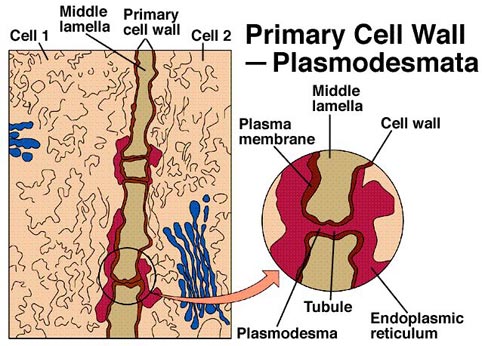

Plasmodesmata (singular, plasmodesma) are microscopic channels of plants facilitating transport and communication between individual cells. Unlike animal cells, plant cells are protected by an impermeable cell wall; and as such, plasmodesmata are required for intercellular activity. Cells can utilize both passive and active transport to move molecules and ions though the passage. A plasmodesma is constructed of three main layers, the plasma membrane, the cytoplasmic sleeve, and the desmotubule.
The plasma membrane portion of the plasmodesma is a continuous extension of the cellular plasmalemma. Similar in structure to most cellular phospholipid bilayers, the plasmodesmal membrane protects from loss of cytosol, protects from foreign materials such as pathogens, and provides anchoring for hydrophobic domains of proteins.
The cytoplasmic sleeve is enclosed by the plasma membrane and is an extension of the cytosol. Normally, no barrier separates the cytoplasma of two cells. Smaller molecules and ions such as sugars and amino acids can easily pass through by diffusion without the need for additional chemical energy. However, the ends of the plasmodesma, called neck regions, can contain closely associated proteins capable of contracting to regulate passage much like animal cell gap junctions.
The desmotubule is a tightly woven phospholipid bilayer covered by actin and myosin filaments which traverses the plasmodesma. The desmotubule is connected directly to the endoplasmic reticulum of each of the adjacent cells forming a channel between the organelles of neighboring cells known as the dynamic endomembrane continuum. As such, the desmotubule is highly involved in intercellular polypeptide and lipid transport. Through the use of ATP, proteins associated with the desmotubule can expand the radius of the plasmodesma allowing larger unfolded proteins to pass through unimpeded.